Facing the Street
"Facing the Street" is the lead article in the new "10,000 arts": mnartists' quarterly arts companion to "The Rake." Look for it now!
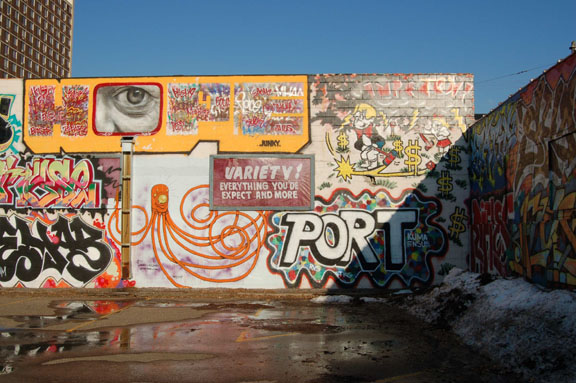
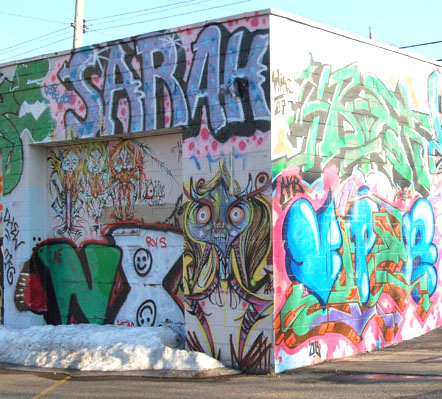
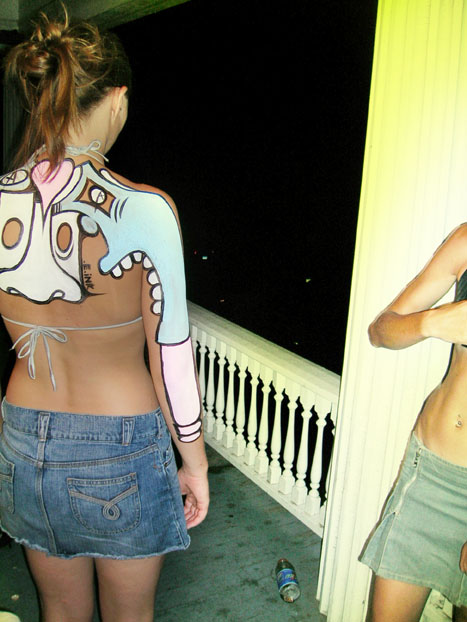
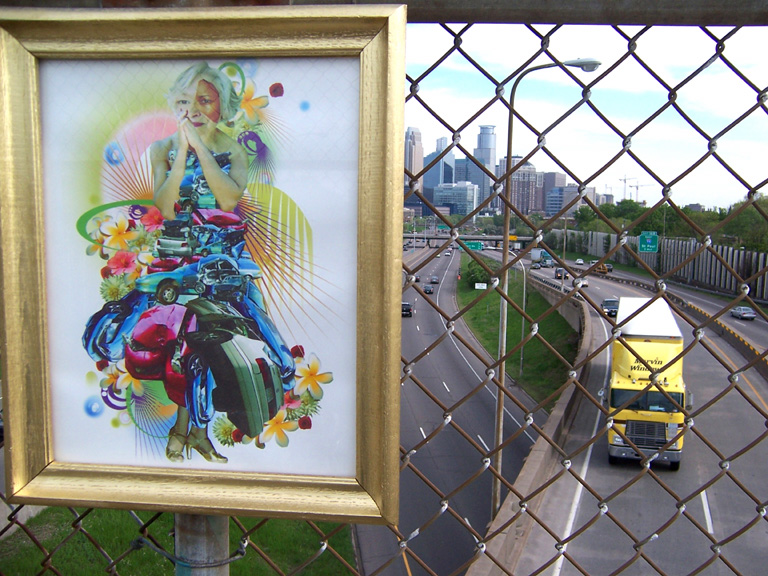
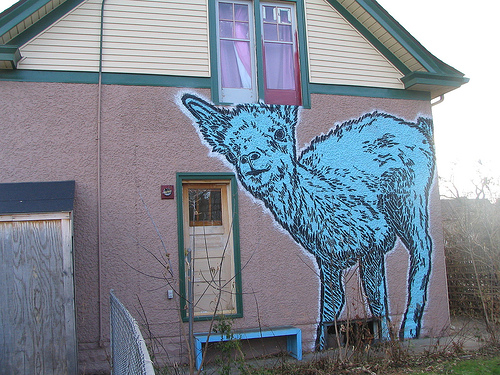
10,000 arts sat down with a group of artists and gallerists who make and deal in art that depends on a street presence and a street aesthetic. Here’s the discussion– among Gabe Combs, Lucas Schulze , Jamie Schumacher of Altered Esthetics, Drew Peterson, John Grider, Suzy Greenberg of Soo VAC Gallery, and Kris Knutson of Robotlove Gallery.
AK: Why do you do this kind of art?
John Grider: I kinda forgot there was anything else to do.
Drew Peterson: I’m still trying to figure it out. . . . It’s just something that keeps going, like a fire. Having something physical. That I make with my own hands.
Gabe Combs: Comes down to, I just gotta do it. I’ve tried to quit. It’s a curse and a blessing.
Lucas Schulze: I do make art but lately I’ve been archiving and curating, working with Jamie [Schumacher] at Altered Esthetics . . . to me art is an alternative form of economy.
Art keeps its value in relation to another person or a community, so it’s got to keep mobile, it’s got to keep meaning going, because that’s how it gains its value.
Drew: I’m trying to communicate with someone who has a particular kind of interaction with public space. The posters I put up are really detailed; it’s not the kind of thing that catches your eye if you’re moving at a fast pace. I’m interested in the interaction of walkers or bikers. It’s really specific to the denizens of the neighborhood, it’s so temporary.
Street art and grafitti, once you put it out there, you lose it, it’s not yours anymore. You have an identity attached to it that builds, but as far as the actual mark, it’s temporary. And I’d like to add one more thing. It’s about control. I mean, it’s an illegal mark, you’re trying to claim it, the site . . . In the US there’s so much importance placed on owning property, that property becomes an extension of yourself, when that’s attacked, that’s political.
John: Really, who knows who the audience is? At this point, pretty much everything is on the Internet. It’s changed everything so much, how people relate to art, how they take it in. Artists of the past, they would work and produce, and then have a show for maybe a month, and that was the only chance to see the work; now you can work and produce, and everyone can see it, you don’t even have to leave your studio.
Kris Knudson: Before, street art was only in particular places. With Jean-Michel Basquiat or Keith Haring, if you wanted the full spectrum their work, you’d have to get it from the gallery, otherwise all you’d have is, you know, “Samo”—just the word on the street. Whereas now, with the Internet, there’s a way to have some of that for yourself, the whole picture.
AK: Obviously this is really changing people’s notions of career. What’s it like now?
Gabe: There’s lots of opportunities to sell art, that’s for sure.
Kris: At Robotlove, I think a lot of artists who are making art and selling have influences that are already marketed, like skateboard design . . . .
AK: Graphic design flows through a lot of artists’ work now, in a way a democratizing force because anyone can buy a T-shirt—
Drew: John and I worked very hard on a show called “Will Work for Food.” A group of artists took a vacant storefront space, the old Theater Antiques building on Lyndale. The show is something we’d like to do about twice a year, making an effort to make it happen for ourselves, working with the community. We’ve found sponsors, so we can build out the space and advertise . . . We can sustain our own lives from it, that’s just something we’re gonna figure out as we go.
John: The opportunity is there to create something annual, biannual, some regular avenue for selling work in all price ranges, without lowering the quality of the work.
AK: There was a few years back a vogue for collectives kind of like yours, like Royal Art Lodge from Winnipeg. They ended up going to Chelsea, and getting dealers, and making a lot of money . . . do you think that there’s a kind of hunger in the artworld at the moment for that kind of authenticity, so that the kind of thing you’re doing can go beyond your immediate community?
John: I think there is –I think for generations it’s been going on but it hasn’t really quite happened yet. But I can feel it happening now.
John: Aesthetically it’s all over the place right now; what we’re all working for.
Kris: I think that, in the high art world, they know something’s happening in the street art world but they’re going to wait and see, wait to see who makes it. There’s attention being paid, there’s an eye on it, but not much direct support. . . . That’s why it’s important that places like Altered Esthetics and Soo VAC exist, it’s how work moves into that next level. . . . It happens in cycles, for a while there was a lot of excitement around local art and then it kind of died out, but I think it’s happening again.
SuzieGreenberg: It’s timing and it’s motivation and skill, like the London scene, Damien Hirst and the other Young British artists . . .
John: Ten years ago I was bored and angry, and I’m still kind of bored and angry, but I found a way to work. If you can find a handful of other people who are likeminded and bored and angry at the same time and who really want to do something about it, that’s when amazing things happen.
Jamie Schumacher: When you asked, how art would be in an ideal world? I think without bored and angry people you’d end up with art that was pretty bland. The ideal world isn’t ideal for doing art; you might end up having a pretty good time but it wouldn’t be good for the kind of art we do.
Drew: It’s about politics, it’s about . . .
Gabe: It cycles through, once the cycle runs through people seem to like, move up and then it all changes. Once people are past their struggle, they just doze, so that whole long struggle is good.
Jamie: People can identify with that—people who can are our audience. You’re working around this overmarketed society–media artists and viral artists are trying to get people to stop tuning out, to tune in consciously . . .
AK: Is the importance of art on the street that it interrupts people?
Drew: It’s confrontational. People can’t get past the fact that it’s illegal, which is too bad.
Sometimes it’s really beautiful, like when the building at Franklin and Riverside got painted, a friend of ours set that up, he painted a beautiful mural, with 25 other grafitti artists. It was a peaceful colorful day when that happened.
John: Some in the community came out to say thank you, and others complained . . .
Gabe: That day was one of the better days I had in months. There was a lot of people there, and people who had bad things to say didn’t say much. It was an act of compassion, an act of art, people just sort of rallied together, it had been really an ugly building . . .
Kris: Sometimes grafitti does come out of something dangerous, but it’s important that media differentiate a mural on a wall from a tag on a dumpster.
Drew: There’s a timeline in the life of a grafitti writer—it can be aggressive, it’s a way to have a powerful voice at a young age that feels energizing. People move in a direction from that young age, it can cycle back and become more aggressive, or it can become different. I mean, if you look at the three of us [Drew, Gabe, and John] – I moved into using more traditional materials, to making more recognized art. People’s careers are based around this early involvement with grafitti. There are a number of extremely well-known graphic designers in this city that were originally grafitti artists—but no, I won’t give them up!
Jamie: You were talking about becoming a “legitimate” artist—are you taking it away from the audience that you started with?
Drew: Not really. Grafitti writers will always look at a city differently from a normal person. We see the physical makeup of the city as offering us something to work from. That’s the beginning of this Work for Food project, we looked at the space, we saw the possibilities, not marking the outside but transforming the inside. And that’s an inspired way of relating to the city.
Jamie: Having it behind closed doors, and legitimate, in that way, are you still going to be doing the same things with your art?
John: I think it’s essentially the same message: self-empowerment, resourcefulness. Everyone related to it differently. In Sao Paolo, they do roller tags with mud on the roofs of buildings. There’s entire books about it. It’s a promise for people who don’t have have resources, they can say, ok, I’m going to make this sculpture that’s gonna end up in a museum.
Gabe: It’s a natural progression. Grafitti artists do move on. Look at Juxtaposition Arts, when I first heard of them I thought, “Sellout!” but now I think they really are giving kids a voice, kids who wouldn’t have one otherwise—stopping kids from getting to the point where they can never have a voice.
Kris: Many artists do both street art and “legitimate” art. There are different audiences. The classic example of supposed “sellout” is Shepard Fairey, putting clothes into the mall and like that. But as he says, “the message hasn’t changed,” and now it’s printed on a thousand t-shirts, and some kid from Blaine can have it, can wear it to school and kids say, what is that, and then they can find out about another street artists. They can participate in that thinking. As a promoter of the arts and a producer, I think, well, the idea that artists shouldn’t make money on this, because it would somehow damage the art, that’s wrong . .
Lucas: At Altered Esthetics a work will get accepted to a show, and an artist will charge like 30 dollars for a piece, because it’s democratic, and they have all these ideals about accessibility, but they don’t have ideals about taking care of their body, which scares me.
When we were talking about people getting pissed off, and having ideals, what you guys are doing, I was thinking one thing that might be different, is you’re curating [Will Work For Food] yourself. The traditional thing in the art world is that patrons and curators aren’t artists, they are mediators between cultures that are totally separate. Artists are supposed to be above and beyond . . . Now you have artists who want to be a part of community, a part of society, and have accountability, and support themselves and eat and pay rent and not have someone else talk about their work for them. So you have more artists becoming curators and taking care of their own.
AK: Recently the Form + Content collective has opened a gallery to show their own work and that of other artists, not because they have to (a lot of these artists are fairly established and have representation and teaching jobs) but because they want to. So I think what you’re saying, Lucas, is accurate—artists want to control their own work.
Gabe: I think you have to be kind of the Renaissance man in order to survive off of art money . . .
Lucas: When someone charges so little for a piece that it doesn’t even add up to what their hourly rates would be during their day job, to me that means that the labor they do that’s meaningless seems more important than this thing they actually care about and love.